3 Install Enterprise Manager Cloud Control
This chapter shows an example of a new installation of Enterprise Manager Cloud Control with Advanced Configuration. The other installation option is to install with a Simple Configuration (for details refer to the Enterprise Manager Cloud Control Documentation at this link on the Oracle Technology Network:
http://docs.oracle.com/cd/E24628_01/index.htm
If you are using an existing Cloud Control installation, you can proceed to Chapter 5, "Import the JD Edwards Application Pack OPAR".
An Oracle database must be installed expressly for use by Cloud Control prior to installing Cloud Control. For reference purposes, this chapter shows an example of installing the Oracle database for use by Enterprise Manager. However, Oracle strongly recommends that you use the OEM Oracle database installation software instructions under the direction of an Oracle DBA.
Note:
This procedure assumes you have obtained the software component for the Oracle Enterprise Manager Cloud Control as described in the chapter of this guide entitled: Section 1.4, "Obtaining Oracle Software Components from the Oracle Software Delivery Cloud".Note:
Oracle recommends you to run the EM Prerequisite Kit before invoking the installer to ensure that you meet all the repository requirements beforehand. Even if you do not run it manually, the installer anyway runs it in the background while installing the product. However, running it manually beforehand sets up your Management Repository even before you can start the installation or upgrade process. For information on the kit, to understand how to run it, and to know about the prerequisite checks it runs, see the applicable appendix in the Enterprise Manager Cloud Control Documentation at this link on the Oracle Technology Network:To install Enterprise Manager Cloud Control with advanced configuration, follow these steps:
Note:
JD Edwards Tools Release 9.1 Update 4. This procedure is updated in this guide to be compatible with Cloud Control content for the supported releases.-
Invoke the Enterprise Manager Cloud Control Installation Wizard.
Invoke the installation wizard as a user who belongs to the
oinstallgroup.Note:
For additional details on managing theoinstallgroup, refer to the applicable chapter in the Enterprise Manager Cloud Control Documentation at this link on the Oracle Technology Network:<Software_Location>/runInstallerIn this command,
<Software_Location>is either the DVD location or the location where you have downloaded the software kit.Note:
- Ensure that there are no white spaces in the name of the directory where you download and run the Enterprise Manager Cloud Control software from. For example, do not download and run the software from a directory titled
EM Softwarebecause there is a white space between the two words of the directory name.
-
When you invoke
runInstaller, if the Enterprise Manager Cloud Control Installation Wizard does not appear, then it is possible that you do not have read and write access to the/stagesubdirectory, which a subdirectory in theDisk1directory of the Enterprise Manager software.There is a classpath variable that the installation wizard computes for OPatch as
../stage/Components/, and when the TEMP variable is set to/tmp, the installation wizard tries to look for the opatch JAR file in the /tmp/../stage directory, which is equivalent to /stage. However, if you do not have read and write permission on /stage, then the installation wizard can hang. Under such circumstances, verify if you have read and write access to the /stage directory. If you do not have, then set the TEMP variable to a location where the install user has access to, and then relaunch the installation wizard.
- Ensure that there are no white spaces in the name of the directory where you download and run the Enterprise Manager Cloud Control software from. For example, do not download and run the software from a directory titled
-
Enter My Oracle Support Details (Optional).
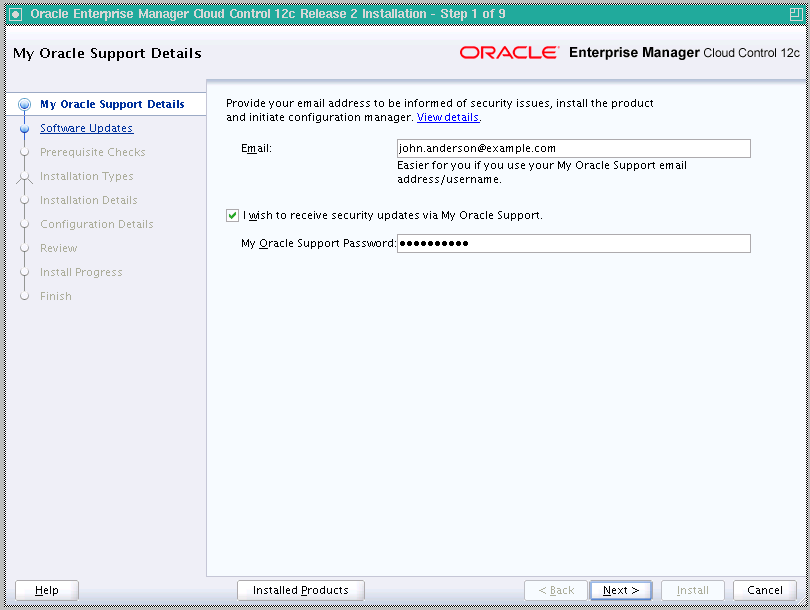
Description of the illustration ''mos_support_details.gif''
(Optional) On the My Oracle Support Details screen, enter your My Oracle Support credentials to enable Oracle Configuration Manager. If you do not want to enable Oracle Configuration Manager now, proceed to the next step in this procedure.
If the host from where you are running the installation wizard does not have a connection to the Internet, then enter only the e-mail address and leave the other fields blank. After you complete the installation, manually collect the configuration information and upload it to My Oracle Support.
-
Click the Next button.
-
Install Software Updates.
Description of the illustration ''software_updates.gif''
On the Software Updates screen, select one of the following sources from where the software updates can be installed while the installation of the Enterprise Manager system is in progress. If you do not want to apply them now, then select the Skip radio button.
Note:
For instructions to manually download the software updates, refer to Oracle Enterprise Manager Cloud Control Advanced Installation and Configuration Guide, which is located in the Enterprise Manager Cloud Control Documentation at this link on the Oracle Technology Network: -
Click the Next button.
If Enterprise Manager Cloud Control is the first Oracle product you are installing on the host that is running on UNIX operating system, then the Oracle Inventory screen appears. You can proceed to the next step in this procedure. Otherwise, the Check Prerequisites screen appears and you can proceed to Step 8 in this procedure.
-
Enter Oracle Inventory Details.
On the Oracle Inventory screen, do the following. You will see this screen only if this turns out to be your first ever installation of an Oracle product on the host.
-
Enter the full path to a directory where the inventory files and directories can be placed.
Note:
- The central inventory location you enter must NOT be on a shared file system. If it is already on a shared file system, then switch over to a non-shared file system by following the instructions outlined in My Oracle Support Document ID 1092645.1
-
If this is the first Oracle product on the host, then the default central inventory location is
<home directory>/oraInventory. However, if you already have some Oracle products on the host, then the central inventory location can be found in the oraInst.loc file. The oraInst.loc file is located in the/etcdirectory for Linux and AIX, and in the/var/opt/oracledirectory for Solaris, HP-UX, and Tru64.
-
Select the appropriate operating system group name that will own the Oracle inventory directories. The group that you select must have write permissions on the Oracle Inventory directories.
-
-
Click the Next button.
-
Check Prerequisites.
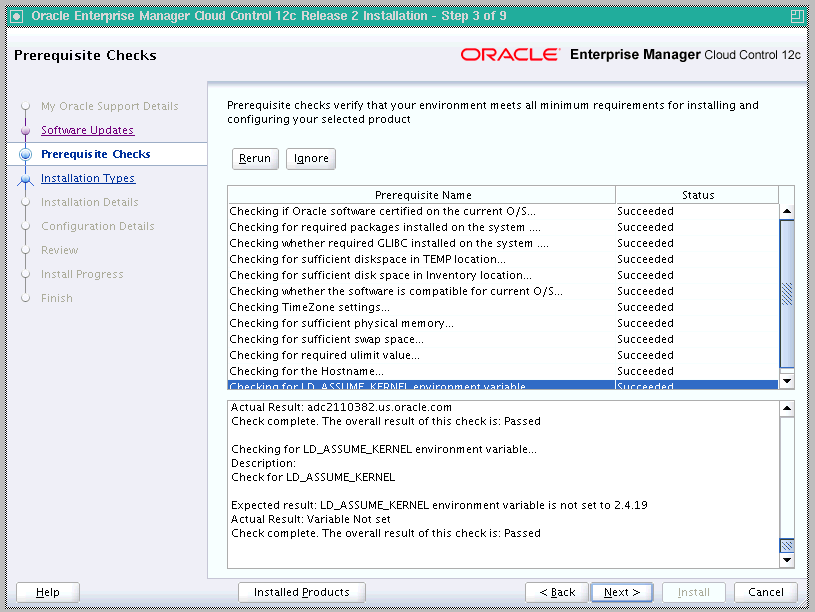
Description of the illustration ''prereq_check.gif''
On the Prerequisite Checks screen, check the status of the prerequisite checks run by the installation wizard, and verify whether your environment meets all the minimum requirements for a successful installation.
The installation wizard runs the prerequisite checks automatically when you come to this screen. It checks for the required operating system patches, operating system packages, and so on.
The status of the prerequisite check can be either Warning, Failed, or Succeeded.
If some checks result in Warning or Failed status, then investigate and correct the problems before you proceed with the installation. The screen provides details on why the prerequisites failed and how you can resolve them. After you correct the problems, return to this screen and click Rerun to check the prerequisites again.
Note:
You can choose to ignore the checks with Warning status by clicking Ignore. However, all package requirements must be met or fixed before proceeding any further. -
Click the Next button.
-
Select Installation Type.

Description of the illustration ''installation_types.gif''
On the Installation Types screen, select Create a New Enterprise Manager System, then select Advanced.
-
Click the Next button.
-
Enter Installation Details.

Description of the illustration ''installation_details.gif''
On the Installation Details screen, do the following:
-
Enter or validate the Middleware home where you want to install the OMS and other core components.
Note:
- If you have Oracle WebLogic Server and Java Development Kit already installed, then ensure that they are of the supported releases—Oracle WebLogic Server 11g Release 1 (10.3.5) and JDK 1.6 v24+. If you have the supported releases, the installer automatically detects them and displays the absolute path to the Middleware home where they are installed. In this case, validate the Middleware home. If the location is incorrect, then enter the path to the correct location. Ensure that the Middleware home you select or enter is a Middleware home that does not have any Oracle homes for Oracle Management Service and Oracle Management Agent.
-
¦If you do not have Oracle WebLogic Server 11g Release 1 (10.3.5) and JDK 1.6 v24+, then the installer automatically installs them for you while installing the Enterprise Manager system. In this case, enter the absolute path to a directory where you want to have them installed. For example,
/oracle/software/. Ensure that the directory you enter does not contain any files or subdirectories. -
If you manually install Oracle WebLogic Server 11g Release 1 (10.3.5), then follow the guidelines outlined in the Before You Begin chapter of in the Enterprise Manager Cloud Control Documentation at this link on the Oracle Technology Network:
-
Enter the absolute path to the agent base directory, a location outside the Oracle Middleware home where the Management Agent can be installed. For example,
/oracle/agent. Ensure that this location is empty and has write permission. Also ensure that it is always maintained outside the Oracle Middleware home. -
Validate the name of the host where you want to configure the OMS.
The host name appears as a fully qualified name. The host name can also appear as a virtual host name if your host is configured with virtual machine.
You can choose to accept the default host name and proceed with the installation. Alternatively, you can change the name if it is incorrect, or enter another host name for this host. Ensure that the host name you enter is accessible from other hosts in the network (other hosts must be able to ping this host).
-
-
Click the Next button.
-
Deploy Plug-Ins.
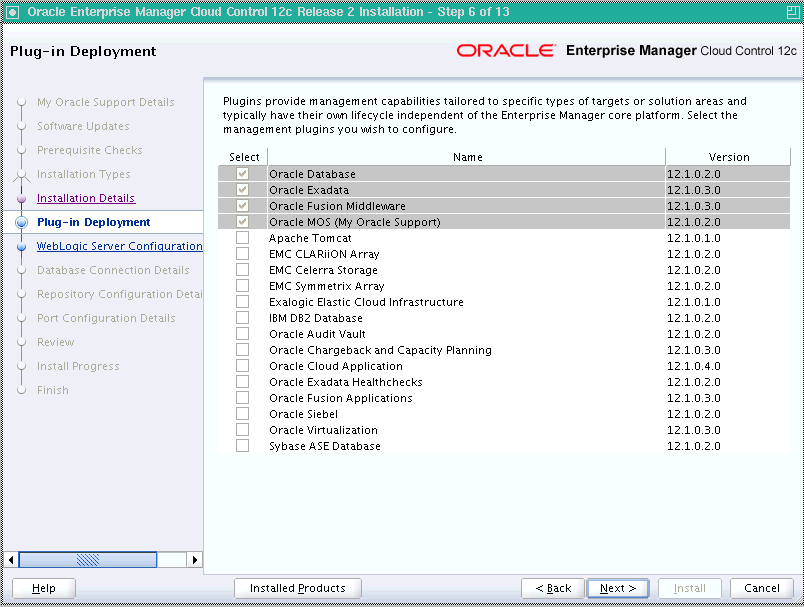
Description of the illustration ''plugin_deployment.gif''
On the Plug-In Deployment screen, select the optional plug-ins you want to install from the software kit (DVD, downloaded software) while installing the Enterprise Manager system.
The pre-selected rows are mandatory plug-ins that will be installed by default. Select the optional ones you want to install.
Note:
During installation, if you want to install a plug-in that is not available in the software kit, then refer to Advanced Installer Options for the point that describes how you can install additional plug-ins. -
Click the Next button.
-
Enter WebLogic Server Configuration Details.
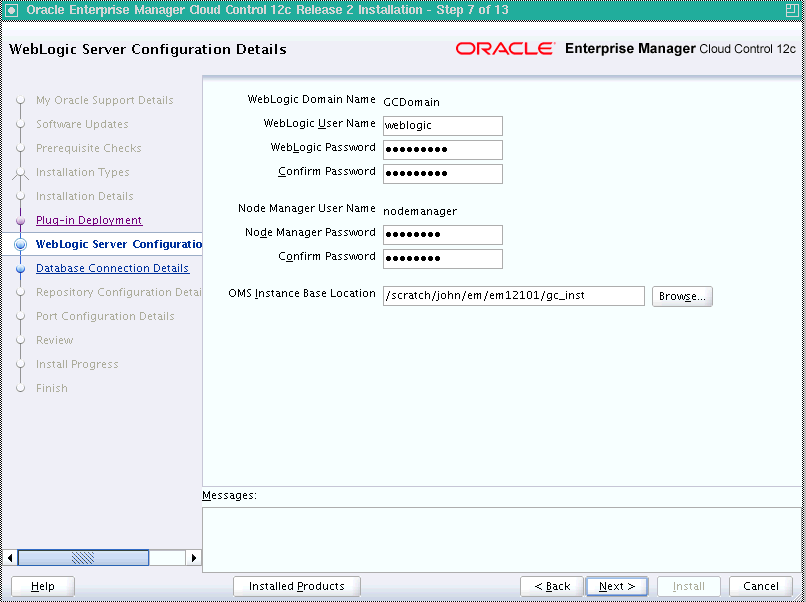
Description of the illustration ''wls_config_details.gif''
On the WebLogic Server Configuration Details screen, enter the credentials for the WebLogic Server user account and the Node Manager user account, and validate the path to the Oracle Management Service instance base location.
Note:
Ensure that your password contains at least 8 characters without any spaces, begins with a letter, and includes at least one numeric value.By default, the WebLogic Domain name is
GCDomain, and the Node Manager name isnodemanager. These are non-editable fields. The installer uses this information for creating Oracle WebLogic Domain and other associated components such as the admin server, the managed server, and the node manager. A Node Manager enables you to start, shut down, or restart an Oracle WebLogic Server instance remotely, and is recommended for applications with high availability requirements.Note:
If you are installing in an NFS-mounted location, and if you see an error message prompting you not to enter an NFS-mounted location for the OMS instance base location, then click Back repeatedly to reach the Software Updates screen. On the Software Updates screen, select an appropriate option to search and apply the patch 14145094. For more information, click Help on that screen.The patch converts the error message to a warning that you can ignore. The installer exits automatically, applies the patch, and invokes itself again for you to proceed with the installation. Once the installation ends, move the lock file location from the NFS-mounted location to a local file system location. Modify the lock file location in the
httpd.conffile to map to the location on the local file system. For instructions, refer to the After You Install chapter in the Enterprise Manager Cloud Control Documentation at this link on the Oracle Technology Network: -
Click the Next button.
-
Enter Database Connection Details.

Description of the illustration ''db_connection_details.gif''
On the Database Connection Details screen, do the following:
-
Provide details of the existing, certified database where the Management Repository needs to be created. If you have already created a database instance with a preconfigured Management Repository using the database templates offered by Oracle, then provide details about that database instance.
The installer uses this information to connect to the existing database for creating the SYSMAN schema and plug-in schemas. If you provide details of a database that already has a preconfigured Management Repository, then the installer only creates plug-in schemas.
Note:
- If you connect to a database instance that was created using the database template offered by Oracle, then note that the password assigned to the user accounts SYSMAN_MDS, SYSMAN_APM, and SYSMAN_OPSS, which were created while preconfiguring the Management Repository, are automatically reset with the SYSMAN password you enter on the Repository Configuration Details screen (as described in Step 20)).
-
Oracle Real Application Cluster (Oracle RAC) nodes are referred to by their virtual IP (vip) names. The
service_nameparameter is used instead of the system identifier (SID) inconnect_datamode, and failover is turned on. For more information, refer to Oracle Database Net Services Administrator's Guide.
-
Select the deployment size from the Deployment Size list to indicate the number of targets you plan to monitor, the number Management Agents you plan to have, and the number of concurrent user sessions you plan have. The following table describes each deployment size.
Deployment Size Targets Count Management Agents Count Concurrent User Session Count Small Up to 999 Up to 99 Up to 10 Medium Between 1000 and 9999 Between 100 and 999 Between 10 and 24 Large 10,000 or more 1000 or more Between 25 and 50
For more information on deployment sizes, the prerequisite checks that are run, the database parameters that are set, and how you can modify the deployment size after installation, refer to Oracle Enterprise Manager Cloud Control Advanced Installation and Configuration Guide.
-
-
Click the Next button.
Note:
- If you connect to a database instance that was created using the database template offered by Oracle, then you will be prompted that the database parameters need to be modified to suit the deployment size you selected. This is because the templates are essentially designed for simple installation, and the database parameters are set as required for simple installation. Since it is used for advanced installation, the parameters must be set to different values. You can confirm the message to proceed further. The installation wizard will automatically set the parameters to the required values.
-
If you are connecting to an Oracle RAC database, and if you have specified the virtual IP address of one of its nodes, then the installation wizard prompts you with a Connection String dialog and requests you to update the connection string with information about the other nodes that are part of the cluster. Update the connection string and click OK. If you want to test the connection, click Test Connection.
-
If your Oracle RAC database is configured with Single Client Access Name (SCAN) listener, then you can enter a connection string using the SCAN listener.
-
Oracle Real Application Cluster (Oracle RAC) nodes are referred to by their virtual IP (vip) names. The service_name parameter is used instead of the system identifier (SID) in connect_data mode, and failover is turned on. For more information, refer to Oracle Database Net Services Administrator's Guide.
-
If you see an error stating that the connection to the database failed with ORA-01017 invalid user name/password, then follow these steps to resolve the issue:
(1) Verify that SYS password provided is valid.
(2) Verify that the database initialization parameter
REMOTE_LOGIN_PASSWORDFILEis set to Shared or Exclusive.(3) Verify that password file with the file name
orapw<SID>exists in the<ORACLE_HOME>/dbsdirectory of the database home. If it does not, create a password file using theORAPWDcommand.
-
Enter Repository Configuration Details.

Description of the illustration ''repository_config_details.gif''
On the Repository Configuration Details screen, do the following:
-
For SYSMAN Password, enter a password for creating the SYSMAN user account. The SYSMAN user account is used for creating the SYSMAN schema, which holds most of the relational data used in managing Enterprise Manager Cloud Control. SYSMAN is also the super administrator for Enterprise Manager Cloud Control.
Note:
- Ensure that your password contains at least 8 characters without any spaces, begins with a letter, and includes at least one numeric value.
-
¦If you connect to a database instance that was created using the database template offered by Oracle, then note that the password assigned to the user accounts SYSMAN_MDS, SYSMAN_APM, and SYSMAN_OPSS, which were created while preconfiguring the Management Repository, are automatically reset with the SYSMAN password you enter on this screen.
-
For Registration Password, enter a password for registering the new Management Agents that join the Enterprise Manager system.
Note:
Ensure that your password contains at least 8 characters without any spaces, begins with a letter, and includes at least one numeric value. -
For Management Tablespace, enter the full path to the location where the data file for management tablespace (
mgmt.dbf) can be stored. The installer uses this information for storing data about the monitored targets, their metrics, and so on. Ensure that the specified path leads up to the file name. -
For Configuration Data Tablespace, enter the full path to the location where the data file for configuration data tablespace (
mgmt_ecm_depot1.dbf) can be stored. This is required for storing configuration information collected from the monitored targets. Ensure that the specified path leads up to the file name. For example:/u01/oracle/prod/oradata/mgmt_ecm_depot1.dbf -
For
JVM Diagnostics Data Tablespace, enter the full path to a location where the data file for JVM Diagnostics data tablespace (mgmt_ad4j.dbf) can be stored. Ensure that the specified path leads up to the file name. Enterprise Manager Cloud Control requires this data file to store monitoring data related to JVM Diagnostics and Application Dependency Performance (ADP). For example:/u01/oracle/prod/oradata/mgmt_ad4j.dbfNote:
If you are configuring the Management Repository on a database that uses Oracle Automatic Storage Management (Oracle ASM) for storage, then when you enter the data file location, only the disk group is used for creating the tablespaces. For example, if you specify+DATA/a.dbf, then only+DATAis used for creating the tablespaces on Oracle ASM, and the exact location of the data file on the disk group is decided by Oracle Managed Files.
-
-
Click the Next button.
-
Customize Ports.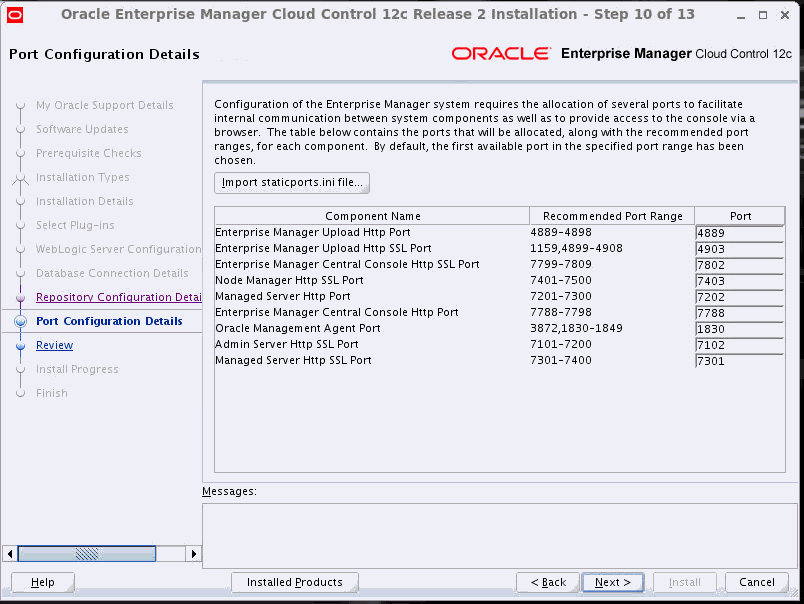
Description of the illustration ''port_config_details.gif''
On the Port Configuration Details screen, customize the ports to be used for various components.
Note:
If all the ports on this screen appear as -1, then it indicates that the installer is unable to bind the ports on the host. To resolve this issue, exit the installer, verify the host name and the IP configuration of this host (ensure that the IP address of the host is not being used by another host), restart the installer, and try again.You can enter a free custom port that is either within or outside the port range recommended by Oracle.
To verify if a port is free, run the following command:
netstat -an | grep <port no>However, the custom port must be greater than 1024 and lesser than 65535. Alternatively, if you already have the ports predefined in a staticports.ini file and if you want to use those ports, then click Import staticports.ini File and select the file.
Note:
- If the
staticports.inifile is passed during installation, then by default, the ports defined in thestaticports.inifile are displayed. Otherwise, the first available port from the recommended range is displayed. -
The
staticports.inifile is available in the following location:<Software_Extracted_Location>/response
- If the
-
Click the Next button.
-
Review and Install.
On the Review screen, review the details you provided for the selected installation type.
-
If you want to change the details, click Back repeatedly until you reach the screen where you want to make the changes.
-
After you verify the details, if you are satisfied, click Install to begin the installation process.
-
-
Track the Progress.
On the Install Progress screen, view the overall progress (in percentage) of the installation and the status of each of the Configuration Assistants. Configuration Assistants are run for configuring the installed components of Enterprise Manager Cloud Control.
Note:
- If a configuration assistant fails, the installer stops and none of the subsequent configuration assistants are run. Resolve the issue and retry the configuration assistant.
For more information, see the appendix on troubleshooting tips in the Oracle Enterprise Manager Cloud Control Advanced Installation and Configuration Guide.
-
If you accidently exit the installer before clicking Retry, then do NOT restart the installer to reach the same screen; instead, invoke the runConfig.sh script from the OMS home to rerun the Configuration Assistant in silent mode.
$<OMS_HOME>/oui/bin/runConfig.sh ORACLE_HOME=<absolute_path_to_OMS_home> MODE=perform ACTION=configure COMPONENT_XML={encap_oms.1_0_0_0_0.xml}If the
runConfig.shscript fails, then clean up your environment and redo the installation.
- If a configuration assistant fails, the installer stops and none of the subsequent configuration assistants are run. Resolve the issue and retry the configuration assistant.
-
Run Scripts.
Once the software binaries are copied and configured, you are prompted to run the allroot.sh script, and the oraInstRoot.sh script if this is the first Oracle product installation on the host. Open another window, log in as root, and manually run the scripts.
If you are installing on Microsoft Windows operating system, then you will NOT be prompted to run this script. You will directly reach the Finish screen as described in the following step of this procedure.
-
End the Installation.
On the Finish screen, you should see information pertaining to the installation of Enterprise Manager. Review the information and click Close to exit the installation wizard.
For more information about this installation, refer to the following file available in the OMS home:
$<OMS_HOME>/install/setupinfo.txtNote:
If the installation fails for some reason, review the log files listed in Oracle Enterprise Manager Cloud Control Advanced Installation and Configuration Guide.Note:
If you have run the installation wizard and let the installation wizard take corrective actions to correct the repository settings, and if you have exited the wizard without completing the installation process, then remember that the repository settings might not reset to their original values because you abruptly ended the installation. In this case, before invoking the installation wizard again, run the following command to manually reset the values.<Software_Location>/install/requisites/bin/emprereqkit -executionType install -prerequisiteXMLLoc <prereq_xml_location> -connectString <connect_string> -dbUser SYS -dbPassword <db_password> -reposUser sysman -reposPassword <repo_user_password> -dbRole sysdba -runPrerequisites -runPostCorrectiveActions -useHistory